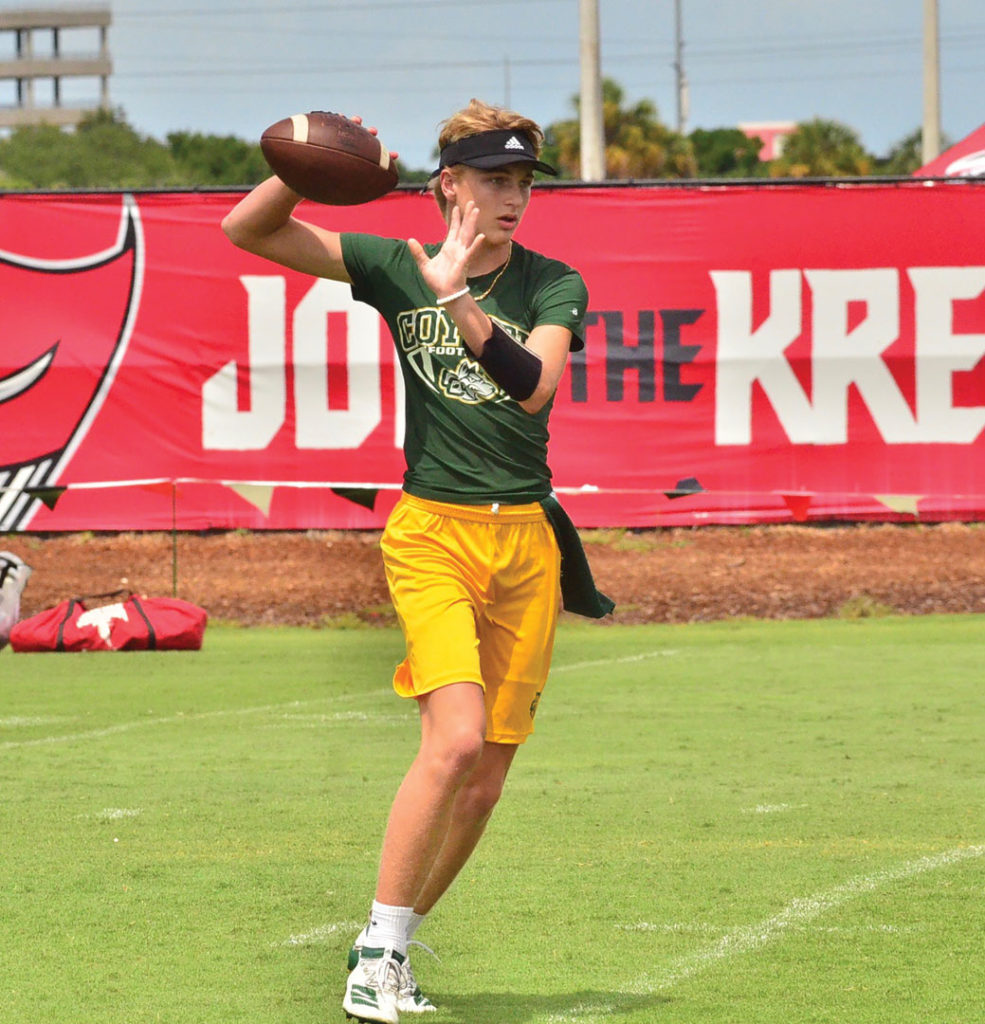
Traditionally, high school football players have generally filled their summers the only way they can — by throwing the ball around, studying the play book, keeping in shape and hitting the weight room.
They aren’t allowed to wear pads in the offseason, so there is no hitting or tackling, and as a result, nothing to play.
But, 7-on-7 football has changed all that. What began as a simple practice drill, ubiquitous from high school all the way up to the pro level, has evolved into a highly competitive sport of its own.
These days, the 7-on-7 “season” is red hot, offering a full-speed, no-contact (really, no more than light contact) way for athletes to hone their skills, build team camaraderie and even attract college recruiters. Increased participation has led to increased organization, and what began as a few local/regional tournaments here and there has evolved into a high-stakes competition that goes all the way to the national level.

Elite area 7-on-7 teams like Team Tampa compete in a national circuit of tournaments, and have a few national titles to show for it.
Wiregrass Ranch High (WRH) quarterback Hunter Helton, getting ready to enter his first year as the Bulls starter under center, led Team Tampa to a title at the Adidas East Coast Regional earlier this summer, and two weeks ago, Team Tampa made it to the elimination bracket at the national tournament held in Tampa before losing 17-14 in the first round.
Current NFL star Cam Newton, the quarterback for the Carolina Panthers, and NFL Hall of Fame defensive back Deion Sanders both coached teams in the event, which was crawling with analysts from recruiting websites. Some of the bigger events also receive cable television coverage.
What is 7-on-7?
The game of 7-on-7 football is exactly that — seven players against seven players. The offense is run by the quarterback, there’s usually a running back or two and then four or five receivers. On defense, 7-on-7 teams mixes usually mix in one or two linebackers and five or six defensive backs.
Quarterbacks have four seconds to unload the ball or it’s whistled as a sack. The teams play on a short field. The offense starts at the 40-yard line and can gain first downs at the 25-yard line and the 10-yard line. You either score, or you turn the ball over.
There are no running plays. Games are 21 minutes long and the clock runs continuously until the final minute. A player is considered downed or tackled by a simple one-hand touch, though it can get very physical during intense match-ups.
The origins of the sport can be traced back to a drill called, “Pass Skel,” or “Skelly,” as some former players recall it. Pass Skel (pass skeleton), aka 7-on-7, is a mainstay practice drill.
Many coaches eschew the 7-on-7 format, saying it invites bad habits and does little to mimic the actual game. Others have embraced it and say keeping their players active, competitive and together is a big payoff.
If you’re are working in a new quarterback for your high school team, the summer circuit of 7-on-7 can be invaluable.
“First, it allows you to practice with the football all year,” says Wesley Chapel High (WCH) head coach Tony Egan. “You develop chemistry between your quarterback and receivers and it helps you get your timing down.”
Egan and the Wildcats are hoping junior Owen Libby steps into the starting quarterback position in the fall of 2019, and they are getting him all the reps they can. The Wildcats played in the second annual King of Kings Tournament at One Buc Place, and currently field two teams in Pasco County’s summer 7-on-7 league held at Fivay High in Hudson.
The competition also allows coaches to add more dimensions and levels to both pass play packages and to their defensive schemes.
“The passing game in high school is 10 times more sophisticated now than when I played (in high school),” says former Tennessee Titans linebacker Ryan Fowler.
“Back then, if you faced a good quarterback, you might not have answers for him unless you had a good pass rush. The NFL has become more of a passing league, and college has followed that, so it’s natural for high school to follow it, too. (7-on-7) offers you months to work on things that you just don’t have time to work on in the fall.”
Coaches like Egan and WRH’s Mark Kantor have embraced the 7-on-7 game, and, with both their teams starting the fall with new starting quarterbacks, building that chemistry on offense will be a significant bonus.
But, they are quick to point out, it’s not “real” football and they often have to remind their players of that.
“The quarterback gets used to taking free drop backs,” Egan says. “We try to do things in practice to simulate pressure like have guys put their hands in the quarterback’s face or hit him with a blocking pad.”
Playing 7-on-7 also gets defensive backs conditioned into a pass-first mentality, and provides a test for linebackers, who often have to drop into pass coverage as well.
“It can take time to break that habit,” Fowler said. “I’ll sometimes make them (defenders) do up-downs after the ball is snapped to slow them down so that their drops are more accurate.”
Egan makes his defenders take a forward run-step before he allows them to drop into coverage.
Coaches have to be wary as well of not falling into a 7-on-7 trap of calling plays and running a defense completely different than they will in the fall.
“We try to run the same coverages we would run in a real game,” Egan said. “It might hurt us in 7-on-7 but we want our kids to know our coverages in the fall.”







No comment yet, add your voice below!